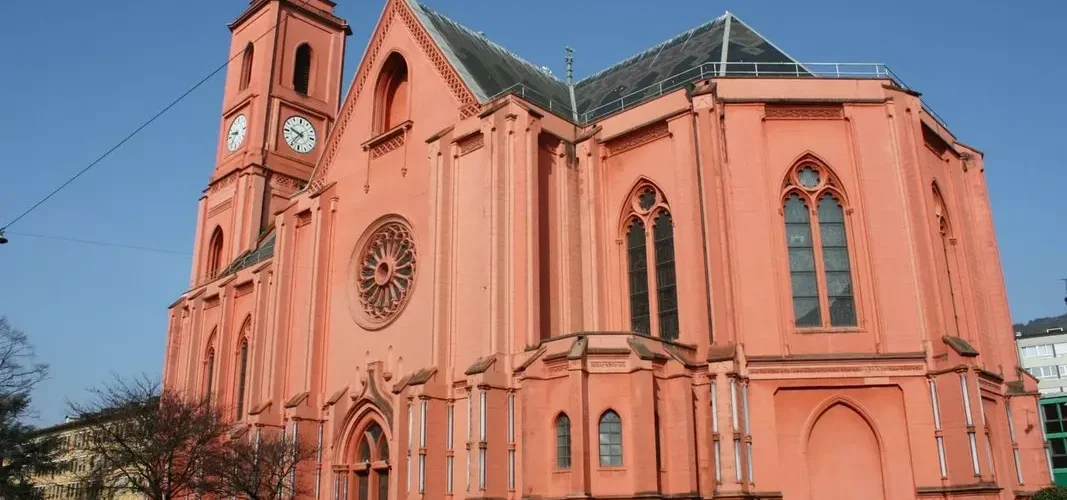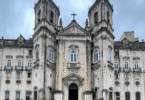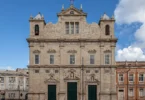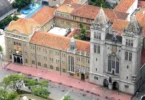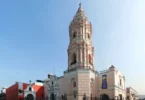Introduction
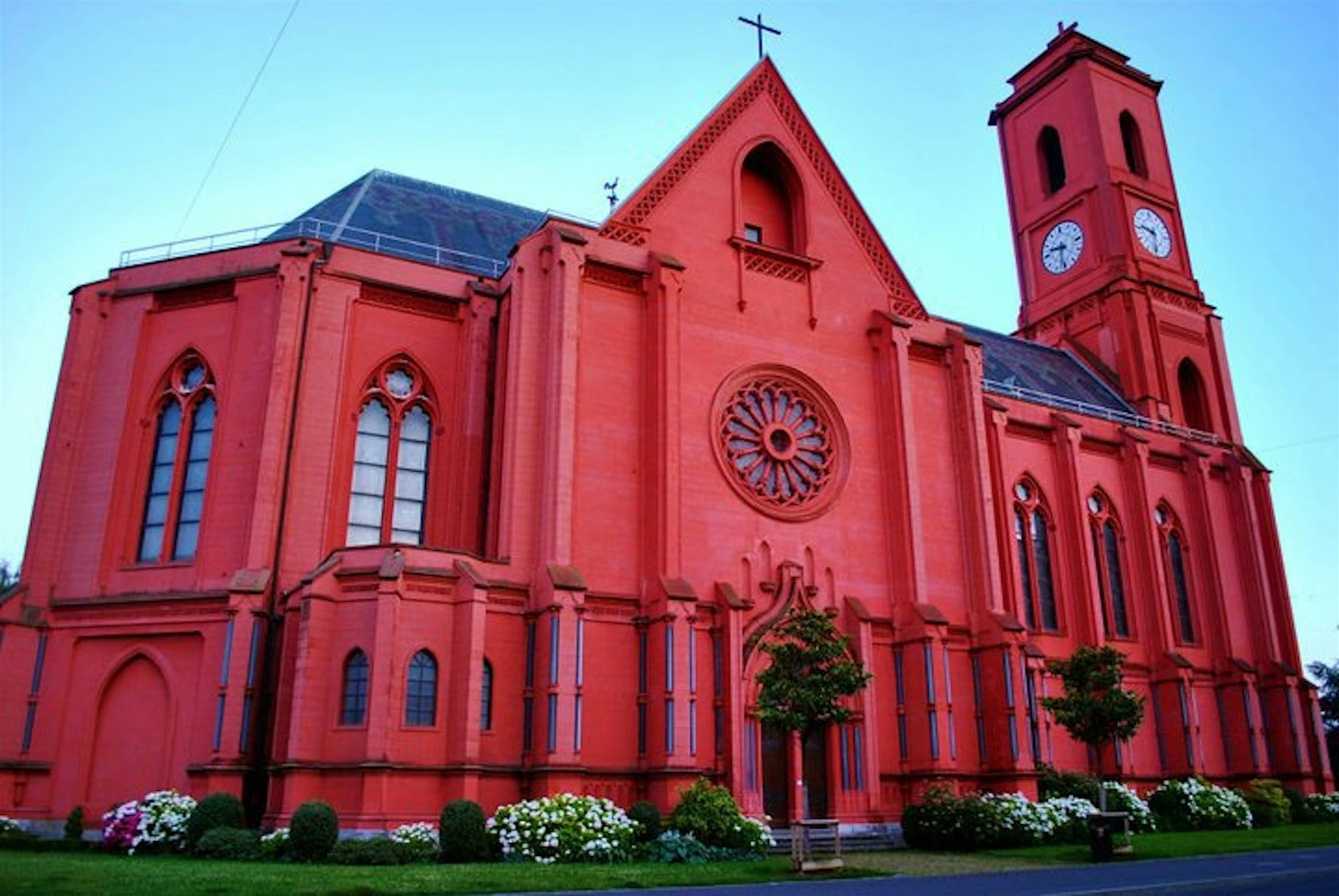
The Basilica of Our Lady of the Assumption in Neuchâtel, often called the Red Church, is a Catholic church that was built between 1897 and 1906. It’s a big, striking building that blends medieval-style design with more modern construction ideas from the time. It doesn’t just stand out for how it looks the church also has real meaning. It represents how Catholicism started gaining more recognition and acceptance in Neuchâtel toward the end of the 1800s.
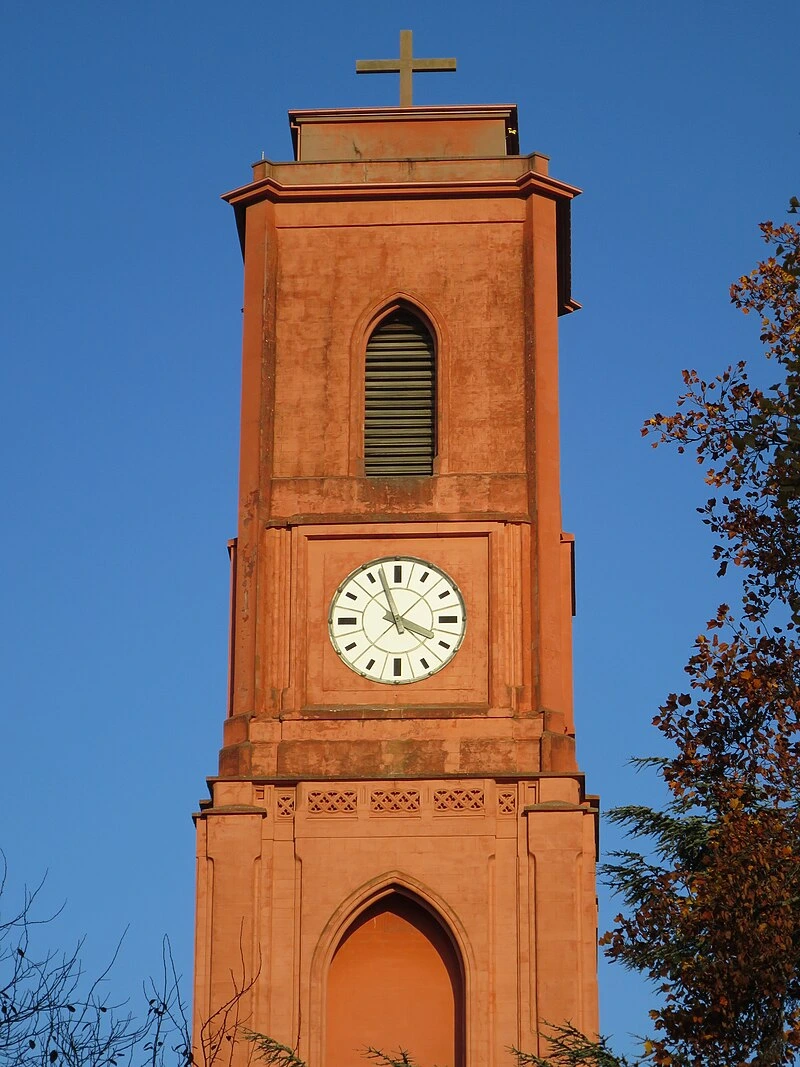
The Revival of Catholic Worship in Neuchâtel
Catholic worship had disappeared from Neuchâtel for centuries after the Reformation in 1530. It wasn’t until 1806 that Catholic Mass returned, first celebrated again in the town’s old Collegiate Church. This moment marked the beginning of a slow but steady revival of Catholic life in the region. By 1827–28, Catholics had their own small chapel built in the Maladière district, near the Pourtalès hospital. It was a modest space, but it was theirs. Over the next few decades, they began laying the foundations literally and figuratively of a stronger Catholic presence. A rectory, a hospital, and a school followed between 1850 and 1870, all within walking distance of the chapel. But as the community grew, so did the need for more space. The chapel couldn’t hold everyone anymore, and it was clear something bigger was needed. By the late 19th century, plans for a new, grand church began to take shape. It wasn’t just about space it was a statement. A visible sign that Catholics were part of Neuchâtel’s fabric again, that they belonged.
The Dream Takes Shape: Twenty Years in the Making
During the 1870s and 1880s, the urban development of Neuchâtel offered religious leaders a favourable context for their designs; the town experienced rapid expansion near Catholic institutions, with land reclaimed from the lake and the creation of the new Beaux-Arts district in particular. A good ten years of negotiations followed between the parish and the municipal authorities regarding the choice of location and its price. The parties finally agreed on March 22, 1897, on the free transfer of land on the edge of the lake, subject to approval of the plans and specifications for the future construction by the Municipal Council. While the location may seem remote to some, the chosen land is close to pre-existing Catholic infrastructure, benefits from good tram service, rests partially on a rocky subsoil, and offers the future church excellent visibility from the lake. A quote was presented to the municipal authorities on November 8, 1897 and the deed of donation of the land was signed in 1900 with the Free Society of Roman Catholics of Neuchâtel, which represented the parish, the latter not having legal personality. Unsurprisingly, financing such a large-scale project proved difficult. More or less successful fundraising attempts followed one another from 1888 onwards, without managing to raise sufficient funds for an undertaking of this scale. A loan from the Banque cantonale neuchâteloise and some substantial donations enabled construction to begin.
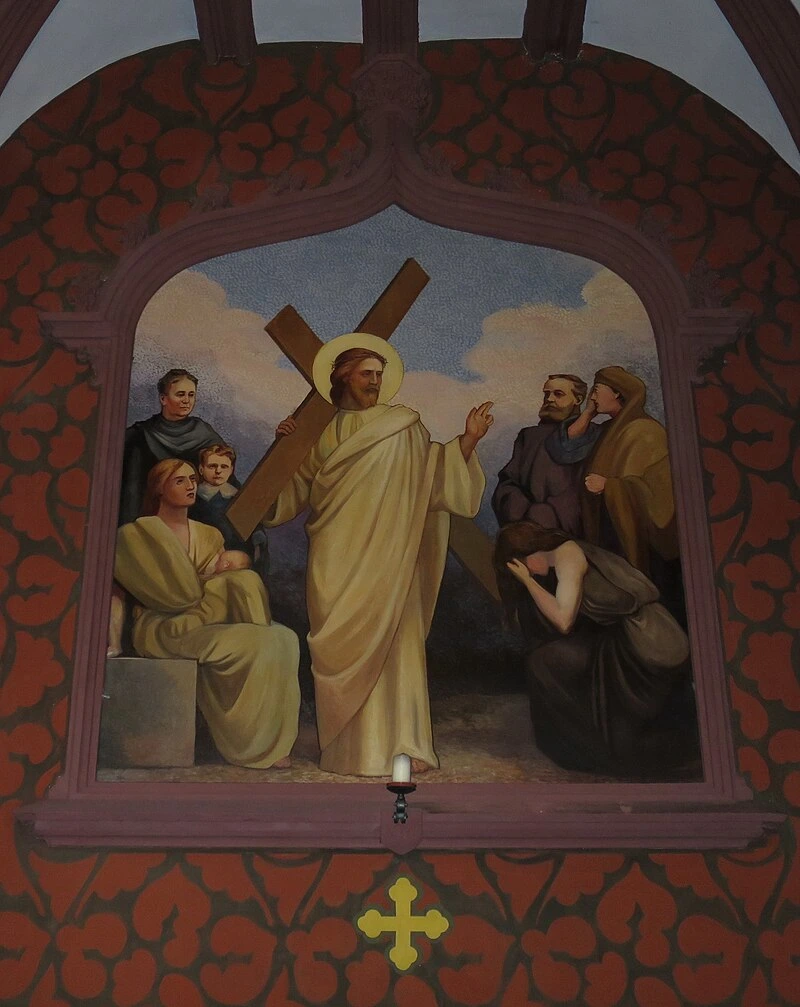
Building the Red Church: 1897–1906
Three architects submitted designs, but it was Guillaume Ritter who got the job. He was part of the Catholic community and already known for designing the local Catholic hospital. Ritter proposed something different a massive neo-medieval structure made with artificial stone, a cost-effective method at the time. Construction began in 1897 but had to pause in 1898 for the town’s 50th anniversary celebration and a national shooting competition. That break helped clear up some financial and planning headaches, and work picked up again in 1899. The cornerstone was blessed in June 1900.
By 1904, the main structure was up except for the tower, which they only finished later. The big day came on March 25, 1906, when the church was officially opened. But inside, things were still a work in progress. The main altar was borrowed from the old chapel. Over the next few decades, more elements were added as funds allowed Stations of the Cross in 1908, painted brocades in 1922, an organ in 1929, bells in the 1930s. Finally, in 1937, a proper high altar was installed, and the church was consecrated. That moment marked the end of a long journey and the beginning of a new chapter for Neuchâtel’s Catholic community.
Architecture of Basilica of Our Lady of the Assumption, Neuchâtel, Switzerland
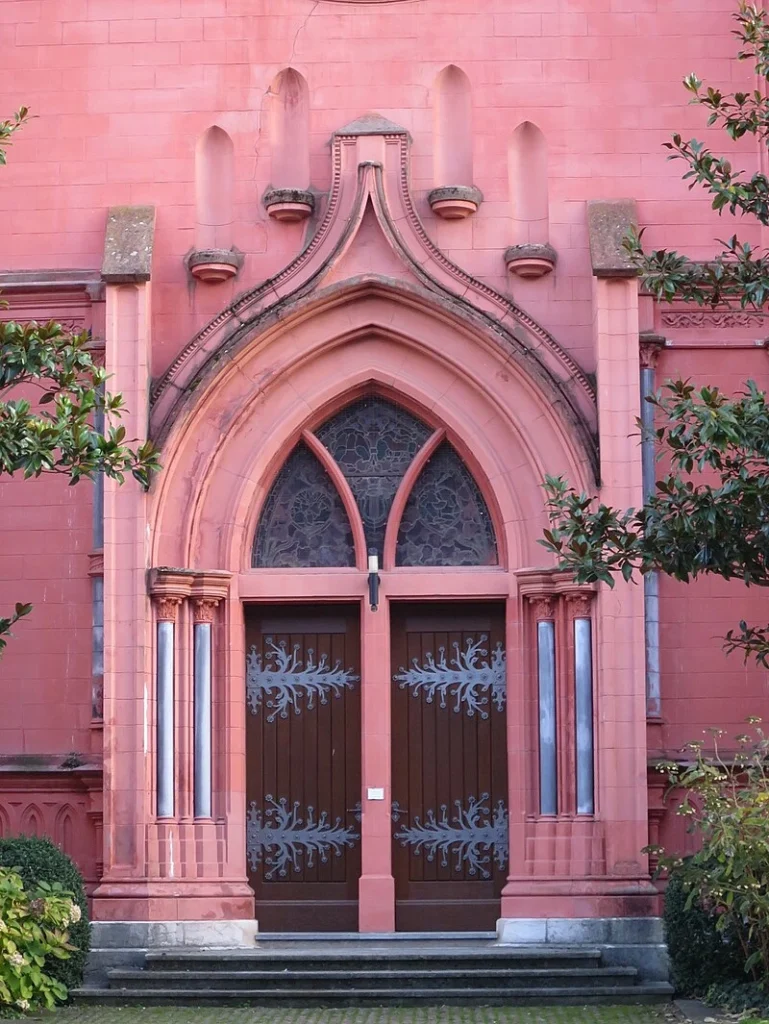
Architect : Guillaume Ritter
Architectural Style : neo-gothic architecture
The North Transept Portal and the Building’s Unique Stone
Guillaume Ritter used a pretty clever technique for the church’s construction. Instead of using regular stone, he chose to make artificial stone right on site. It’s basically cement mixed with lime and gravel, all tinted red to match the look of Rhine sandstone a nod to both local tradition and Ritter’s Alsace roots. They poured this mix into molds to create everything they needed, from simple blocks to detailed decorations like columns and capitals. This method gave Ritter a lot of freedom to shape the building exactly how he wanted while also cutting down costs and speeding up construction. But there was a catch: over time, the decorative parts started to wear down and get fragile. By the 1920s, they already had to start repairs because the outside decorations were at risk of crumbling.
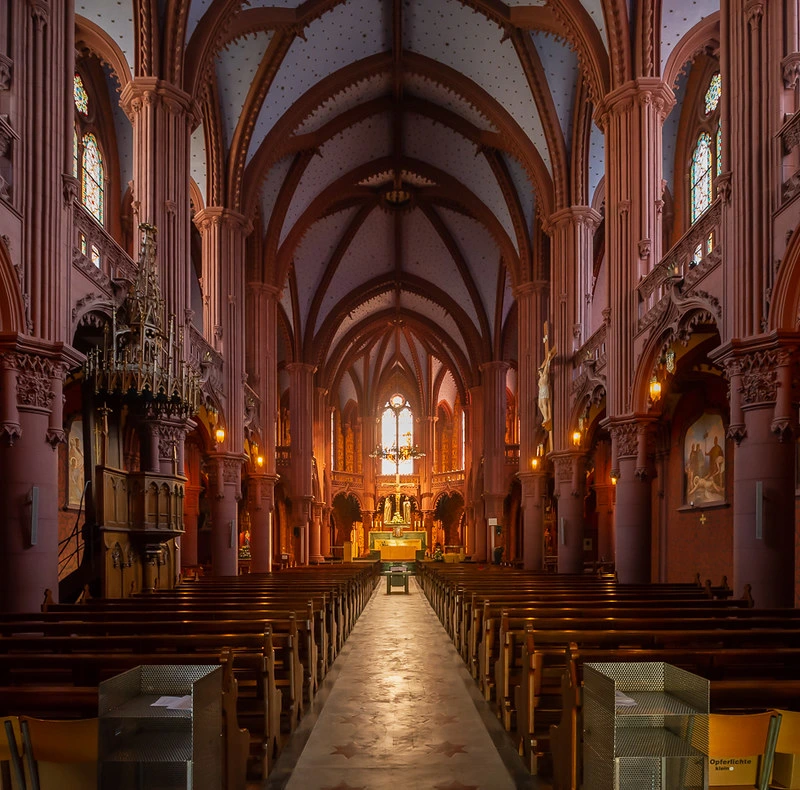
Inside and Out — The Power of Neo-Medieval Design
The church stands out not just because of its deep red color but also because of its size. It’s huge about 66 by 32 meters, with space for around 1,300 people. The tall bell tower, almost 54 meters high, can be seen from far away. Its shape and style borrow heavily from medieval Gothic churches pointed arches, big stained glass windows, pinnacles, and all that. It has a classic basilica layout with a big nave, side aisles, a transept, and a polygon-shaped choir with an ambulatory behind it. But Ritter wasn’t just copying old styles blindly. He mixed tradition with some modern tweaks. For example, he left out flying buttresses and made all three naves the same height, which wasn’t common in old Gothic churches. He also added a spacious gallery. Money was tight, so some features got simplified too the original plan called for a stone spire on the tower, but they settled for a flat platform with a railing instead.
A Blend of Influences
Ritter was well-versed in medieval architecture and pulled inspiration from across Europe from Portugal to Germany and included local touches like the tower of Fribourg Cathedral. The church seems to be in a kind of conversation with the nearby Collegiate Church, both cooperating and competing in style. In the end, the Red Church is a unique mix of tradition and innovation all shaped by Ritter’s passion for medieval art and modern building techniques.
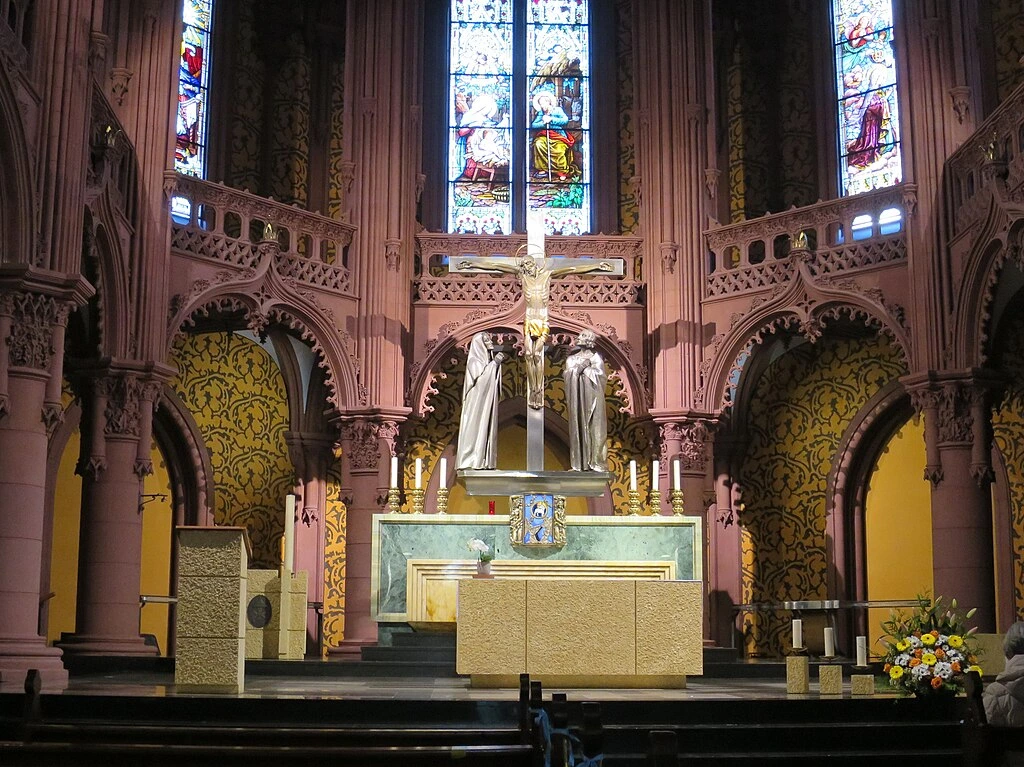
Interior design: furniture and decor
In addition to the abundance, quality and fantasy that characterizes its neo-medieval ornamentation, the Notre-Dame church has interesting furniture, paintings and sculptures that combine neo-Gothic productions with contemporary creations of the highest quality. The side altars, the pulpit, the pews and the stained glass windows were among the first installations, like the stained glass windows of the choir installed in 1905 by the Champigneule company of Bar-le-Duc (France) and those of the nave made at the same date by the firm Enneveux & Bonnet of Geneva. In 1908, the installation of the fourteen panels of the Stations of the Cross painted by Abbot François Moirod of Cousance (France) announced the ornamentation to come. The original bareness of the walls was finally dressed in 1922, by means of a stencilled decoration evoking the brocade motifs of the 15th century. Although the city had been providing support since 1904, it was not until the Federal Song Festival held in Neuchâtel in July 1912 that the monumental four-dial clock planned for the bell tower was put into operation. Its innovative mechanism, supplied by David Perret du Plan, suffered numerous setbacks before being replaced in 1916 by a more conventional movement supplied by the Neuchâtel School of Mechanics and Watchmaking.
From 1929, a symphonic organ the size of the church replaced the temporary instrument that had animated the celebrations until then. Generous donors allowed the installation of three bells in 1933-1934, as well as the redevelopment of the choir under the direction of the architect Fernand Dumas of Fribourg in 1937. On this occasion, the break with historicism was consummated, the neo-medieval style was abandoned in favor of a contemporary approach in the spirit of the Saint-Luc Group . This is particularly the case of the high altar of which the goldsmith Calvary by Marcel Feuillat of Geneva constitutes the centerpiece. The last major intervention, the development of the Chapel of the baptismal fonts was the work of Yoki for the sculpture and the Angeloz brothers for the mosaic in 1959.
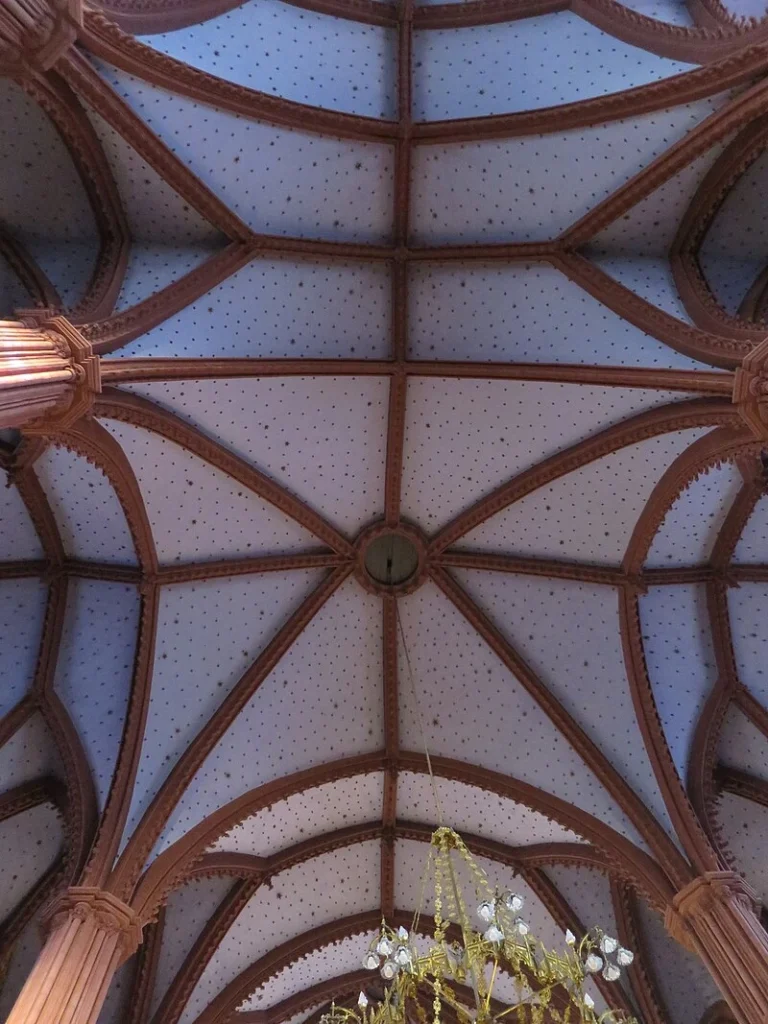
Maintenance and Restoration
Fragility and purification of ornaments
A source of savings at the time of the church’s construction, artificial stone quickly became a major source of concern for the parish. From the 1920s onwards, the condition of the exterior decorations deteriorated to the point of constituting a threat to passers-by for around thirty years. An initial assessment, followed by consolidation work, was carried out in 1920 under the direction of Otto Schmid, an architect specialising in the restoration of historic monuments. Despite annual inspections and minor maintenance work, the deterioration continued, leading to a general renovation of the building in 1955-56; the sanitation measures included the removal of the courtyard, the drastic reduction of the exterior decoration, the simplification of the crowning and the installation of a cross at the top of the tower.
Heritage recognition and conservation work
Despite numerous maintenance works (roof), upgrading (electricity, heating) and modernisation (bells, clock), the building continued to deteriorate and the repairs were expensive, without meeting the expectations of the faithful, to the point of leading the parish to consider the demolition of the church and its replacement by a contemporary construction better suited to its needs. The debate which took place within the Catholic authorities and heritage specialists finally led in 1984 to the recognition of the architectural and historical qualities of the Notre-Dame church and its conservation. The building was placed under protection as a historic monument in 1986 and registered as a cultural property of national importance. The complete restoration programme drawn up would occupy the parish authorities and heritage bodies for more than a decade. The work began with the repair of the roofs (1986-87), before continuing with the treatment of the facades and stained glass windows (1991-97), and ending with the interior restoration (1998-2000). Everything was done to preserve the original substance, as well as the 20th century additions, and among the long list of work carried out, we should limit ourselves to mentioning two elements: the entire exterior surface was repainted to mask the unsightly efflorescence of saltpeter, as had already been the case at the beginning of the 20th century , and inside, the 10,000 molded cement stars that adorn the ceiling were regilded with bronze paint. Like these two examples. In keeping with the spirit of Vatican II, contemporary developments have completely restored the heritage: redesign of the reception area, creation of a crypt suitable for meditation in the old vault located under the high altar, transformation of the bell tower room into a multi-purpose room and partial modernization of the liturgical furniture.
Feast Day
Feast Day : 15 JAugust
The feast day of the Basilica of Our Lady of the Assumption in Neuchâtel is on August 15, which is the Feast of the Assumption of Mary. This is the day when Catholics celebrate the belief that Mary was taken up to heaven. The basilica usually holds special Masses and events to mark the occasion.
Church Mass Timing
Monday to Friday : 6:15 PM.
Saturday : 5:00 PM
Sunday : 10:00 AM , 6:00 PM
Church Opening Time:
Monday to Sunday : 8:00 am – 6:00 pm.
Contact Info
Address : Our Lady of the Assumption of Neuchâtel
Rue Abram-Louis-Breguet 5-11, 2000 Neuchâtel, Switzerland.
Phone : +41 32 725 19 89
Accommodations
Connectivities
Airway
Basilica of Our Lady of the Assumption, Neuchâtel, Switzerland, to Aérodrome Neuchâtel, distance 12 min (11.7 km) via A5.
Railway
Basilica of Our Lady of the Assumption, Neuchâtel, Switzerland, to Neuchâtel Railway station, distance between 7 min (2.6 km) via Rue du Rocher.

